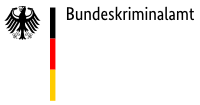
With messages written by offenders, the composition of the writing materials and the paper used can also be of interest, for example, as an additional attribute which can help determine the author on the basis of matching handwritings or mechanically produced prints and copies.
 The chromatogram displays differences in the isolated mixtures of colouring materials used in different ballpoint pen inks.
The chromatogram displays differences in the isolated mixtures of colouring materials used in different ballpoint pen inks.
Chromatographic procedures are predominantly used in the analysis of text dyes in liquids and pastes, such as inkjet inks or coloured ballpoint pen inks. These are primarily high performance thin layer chromatography (HPTLC) as well as the high performance liquid chromatography (HPLC) procedures. In both cases, the available colouring material mixtures are isolated and used for the purpose of determination and/or product allocation.
A frequent goal of the tests is to identify devices utilised during the production of letters or documents, such as for example inkjet and laser printers, or typewriters and printing machines.
The methods by which toner material was fixed onto paper can be determined microscopically. With the assistance of a magneto-optic magnifying glass it can be determined relatively simply whether the toner material used is magnetic or not. Toner material consists of pigments, synthetic resins and low-molecular auxiliary materials.
 SEM photos of toner material
SEM photos of toner material
One can gain an impression of their chemical composition by means of infrared (IR), which can be utilised for comparisons of sensitive materials, for example, between unknown toner samples taken from various letters claiming responsibility for offences.
Up until a few years ago, it was still necessary to damage test documents by extracting samples, but today one can do without the complex preparation of samples.
 ATR crystal during the measuring process
ATR crystal during the measuring process
IR microscopy carried out under attenuated total reflection measuring conditions (ATR technology), makes it possible to examine print-outs of electro photography devices virtually without damage. In this case a special lens built into the IR microscope is used, whose measuring crystal is brought directly into contact with the toner surface.
 SEM photos of toner material
SEM photos of toner material
 Print-out showing photo-conductor drum defect. The characteristic can be seen several times in the print-out, whereby even the circumference and/or diameter of the photo-conductor drum can be determined.
Print-out showing photo-conductor drum defect. The characteristic can be seen several times in the print-out, whereby even the circumference and/or diameter of the photo-conductor drum can be determined.
For the forensic analysis of toner material, scanning electron microscopy (SEM) conclusively offers an optimal analytical enhancement with highly resolved detail imaging and additional locally resolved information about element distribution (SEM/EDX).
Laboratory results gathered in such a way allow for the ascertainment of the system employed, i.e. they can be translated into equipment models including their technical specification. This is only possible, however, through means of extensive product collections supported by appropriate IT processing. Such collections are maintained in a standard manner in the field of documents.
 Segment of a photo-conductor with drum defect
Segment of a photo-conductor with drum defect
In order to reach further conclusions, so-called individual characteristics within the letter must be capable of being recognised. These can be defects, or distinctive features caused by the manufacturing process, which can be recognised on the image carrier (paper). A typical example from electro-photographic devices is the photo-conductor drum defect, which can be recognized in the print-out or picture copied. On the basis of such defects, it is possible to attribute a letter exclusively to one specific piece of equipment.
